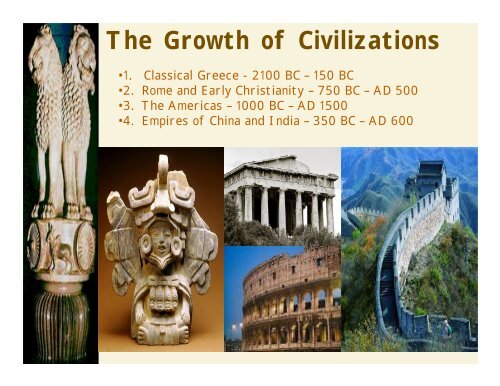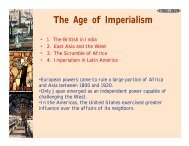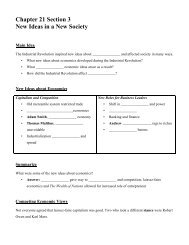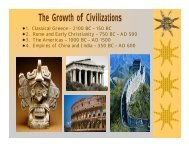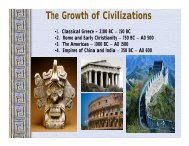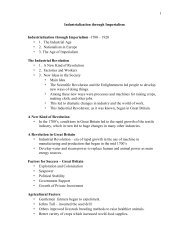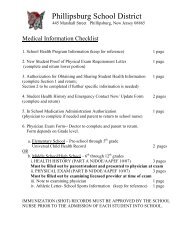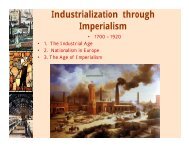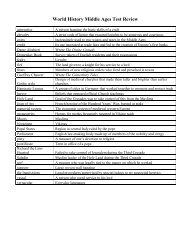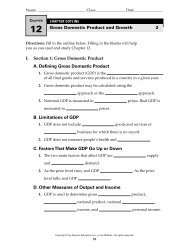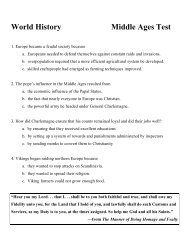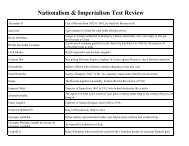Empires of China and India,350 BC to AD 600 - Phillipsburg School ...
Empires of China and India,350 BC to AD 600 - Phillipsburg School ...
Empires of China and India,350 BC to AD 600 - Phillipsburg School ...
Create successful ePaper yourself
Turn your PDF publications into a flip-book with our unique Google optimized e-Paper software.
The Growth <strong>of</strong> Civilizations<br />
•1. Classical Greece - 2100 <strong>BC</strong> – 150 <strong>BC</strong><br />
•2. Rome <strong>and</strong> Early Christianity – 750 <strong>BC</strong> – <strong>AD</strong> 500<br />
•3. The Americas – 1000 <strong>BC</strong> – <strong>AD</strong> 1500<br />
•4. <strong>Empires</strong> <strong>of</strong> <strong>China</strong> <strong>and</strong> <strong>India</strong> – <strong>350</strong> <strong>BC</strong> – <strong>AD</strong> <strong>600</strong>
<strong>Empires</strong> <strong>of</strong> <strong>China</strong> <strong>and</strong> <strong>India</strong><br />
<strong>350</strong> <strong>BC</strong> <strong>to</strong> <strong>AD</strong> <strong>600</strong><br />
•1. The Growth <strong>of</strong> <strong>China</strong><br />
•2. Chinese Society <strong>and</strong> Culture<br />
•3. <strong>India</strong>n Dynasties<br />
•4. <strong>India</strong>n Society <strong>and</strong> Culture<br />
• 300 – 200 <strong>BC</strong>, strong empires unified much <strong>of</strong> <strong>China</strong> <strong>and</strong><br />
<strong>India</strong><br />
•Under these empires, <strong>China</strong> <strong>and</strong> <strong>India</strong> became prosperous<br />
•Led <strong>to</strong> classical periods in their his<strong>to</strong>ries, during which <strong>China</strong><br />
<strong>and</strong> <strong>India</strong> developed many <strong>of</strong> the characteristics that would<br />
define their modern times
<strong>350</strong> <strong>BC</strong> – <strong>AD</strong><strong>600</strong><br />
1. The Growth <strong>of</strong> <strong>China</strong><br />
•Qin <strong>and</strong> the Han<br />
<strong>350</strong> <strong>BC</strong> <strong>to</strong> <strong>AD</strong> <strong>600</strong>
The Qin Dynasty<br />
<strong>350</strong> <strong>BC</strong> – <strong>AD</strong><strong>600</strong><br />
•300’s <strong>BC</strong>, the Warring States Period –<br />
•era in which the Qin state began <strong>to</strong> dominate the other states <strong>of</strong><br />
<strong>China</strong>
<strong>350</strong> <strong>BC</strong> – <strong>AD</strong><strong>600</strong><br />
Qin [Ch’in] Dynasty<br />
• Established <strong>China</strong>’s first empire<br />
<br />
• Shi Huangdi (First Emperor)<br />
•Legalist rule <br />
•A powerful <strong>and</strong> efficient<br />
government was key <strong>to</strong><br />
maintaining order<br />
•Bureaucratic administration<br />
•Centralized control<br />
•Military expansion<br />
•Book burnings targeted<br />
Confucianists<br />
•Buried protes<strong>to</strong>rs alive!<br />
• Built large section <strong>of</strong> the Great<br />
Wall
Shi Huangdi’s Terra Cotta<br />
Army<br />
<strong>350</strong> <strong>BC</strong> – <strong>AD</strong><strong>600</strong><br />
•Discovered in 1974 - the immense army <strong>of</strong> the dead<br />
•A Paranoid Emperor in hope <strong>of</strong> gaining immortality had artisans create a<br />
life-size army with chariots, horses, <strong>and</strong> more than 7,000 soldiers <strong>to</strong> guard<br />
him in the afterlife
Shi Huangdi’s Terra Cotta<br />
Army<br />
<strong>350</strong> <strong>BC</strong> – <strong>AD</strong><strong>600</strong><br />
•Army placed in pits around the emperor’s <strong>to</strong>mb
<strong>350</strong> <strong>BC</strong> – <strong>AD</strong><strong>600</strong><br />
Individual “Tombs”
<strong>350</strong> <strong>BC</strong> – <strong>AD</strong><strong>600</strong><br />
Terra Cotta Soldiers & Cavalrymen<br />
•Although harsh, Qin policies under Huangdi unified <strong>and</strong> strengthened <strong>China</strong>.<br />
•He under<strong>to</strong>ok massive building projects, including an improved irrigation<br />
system, an exp<strong>and</strong>ed network <strong>of</strong> roads <strong>and</strong> canals, <strong>and</strong> a defensive wall.
Cavalry<br />
<strong>350</strong> <strong>BC</strong> – <strong>AD</strong><strong>600</strong><br />
•Despite improvements in trade <strong>and</strong> transportation, peasants had<br />
<strong>to</strong> pay heavy taxes <strong>and</strong> some were forced <strong>to</strong> work on them
Individual Soldiers<br />
<strong>350</strong> <strong>BC</strong> – <strong>AD</strong><strong>600</strong>
<strong>350</strong> <strong>BC</strong> – <strong>AD</strong><strong>600</strong><br />
Details <strong>of</strong> an Individual Soldier
<strong>350</strong> <strong>BC</strong> – <strong>AD</strong><strong>600</strong><br />
Great Wall, Shanhai Pass<br />
•To strengthen security <strong>and</strong> protect his empire from outside<br />
threats, Shanhai had workers join the separate defensive walls<br />
creating the Great Wall <strong>of</strong> <strong>China</strong>
<strong>350</strong> <strong>BC</strong> – <strong>AD</strong><strong>600</strong><br />
The Great Wall with Towers<br />
•Hundreds <strong>of</strong> thous<strong>and</strong>s <strong>of</strong> peasants were forced <strong>to</strong> work on<br />
the wall <strong>and</strong> many people died from the harsh labor.
The Han Dynasty<br />
<strong>350</strong> <strong>BC</strong> – <strong>AD</strong><strong>600</strong><br />
•When Shi Huangdi died in 210 <strong>BC</strong>, the Qin Dynasty crumbled in<br />
rebellion. Liu Bang, a peasant leader, founded the Han dynasty, one<br />
<strong>of</strong> the greatest dynasties in Chinese his<strong>to</strong>ry
Han Dynasty<br />
<strong>350</strong> <strong>BC</strong> – <strong>AD</strong><strong>600</strong><br />
•“People <strong>of</strong> the Han” original Chinese<br />
•Paper invented [105 B.C.E.] <br />
•Silk Road trade develops; improves life for many<br />
•Buddhism introduced in<strong>to</strong> <strong>China</strong><br />
•Exp<strong>and</strong>ed in<strong>to</strong> Central Asia
Liu Bang Tomb<br />
<strong>350</strong> <strong>BC</strong> – <strong>AD</strong><strong>600</strong><br />
• His jade suit has 2498 pieces! He ruled with the m<strong>and</strong>ate <strong>of</strong><br />
heaven (approval <strong>of</strong> the gods)<br />
• He re-instituted Confucianism <strong>and</strong> at the same time kept<br />
some Legalist policies <strong>to</strong> maintain firm control over his<br />
empire
Emperor Wudi<br />
<strong>350</strong> <strong>BC</strong> – <strong>AD</strong><strong>600</strong><br />
•One <strong>of</strong> the Greatest<br />
Han emperors<br />
•Started public schools.<br />
•Colonized Manchuria,<br />
Korea, & Vietnam.<br />
•Civil service systempass<br />
an exam in the<br />
Confucian classics<br />
bureaucrats<br />
•Confucian scholargentry<br />
•Revival <strong>of</strong> Chinese<br />
l<strong>and</strong>scape painting.
<strong>350</strong> <strong>BC</strong> – <strong>AD</strong><strong>600</strong><br />
Emperor Wudi <strong>and</strong> Expansion<br />
•Martial Emperor -<br />
exp<strong>and</strong> his empire<br />
through warfare<br />
•Xiongnu-nomads who<br />
lived in the grassl<strong>and</strong>s<br />
<strong>of</strong> n. <strong>China</strong>
The Han Decline<br />
•In 184, a Daoist sect called the Yellow Turbans rebelled<br />
<strong>and</strong> through the empire in<strong>to</strong> chaos<br />
•Period <strong>of</strong> Disunion - <strong>350</strong> years <strong>of</strong> warfare<br />
<strong>350</strong> <strong>BC</strong> – <strong>AD</strong><strong>600</strong>
2. Chinese Society <strong>and</strong> Culture<br />
Trade Routes <strong>of</strong> the Ancient World<br />
<strong>350</strong> <strong>BC</strong> – <strong>AD</strong><strong>600</strong><br />
• The Silk Road network <strong>of</strong> trade routes that stretched from <strong>China</strong><br />
4,000 miles across the heart <strong>of</strong> Asia <strong>to</strong> the Mediterranean Sea
Ruins <strong>of</strong> Jiaohe, Turphan<br />
depression.<br />
•Han dynasty outpost in Central Asia<br />
<strong>350</strong> <strong>BC</strong> – <strong>AD</strong><strong>600</strong>
<strong>350</strong> <strong>BC</strong> – <strong>AD</strong><strong>600</strong><br />
Chang’an: The Han Capital
Han Artifacts<br />
<strong>350</strong> <strong>BC</strong> – <strong>AD</strong><strong>600</strong><br />
Imperial<br />
Seal<br />
Han Ceramic House<br />
•The Han period was a Classical age in <strong>China</strong><br />
his<strong>to</strong>ry.<br />
•During this age, art flourished <strong>and</strong> science <strong>and</strong><br />
technology improved life.
<strong>350</strong> <strong>BC</strong> – <strong>AD</strong><strong>600</strong><br />
Ceramics, Later Han Period<br />
•The Spread <strong>of</strong> Buddhism <strong>to</strong> <strong>China</strong>, led <strong>to</strong> an increase in Buddhist<br />
art <strong>and</strong> statues
Acupuncture<br />
<strong>350</strong> <strong>BC</strong> – <strong>AD</strong><strong>600</strong><br />
•Inserting fine needles<br />
in<strong>to</strong> the skin at specific<br />
points <strong>to</strong> cure disease<br />
<strong>and</strong> relieve pain
3. <strong>India</strong>n Dynasties<br />
The Maurya Empire<br />
<strong>350</strong> <strong>BC</strong> – <strong>AD</strong><strong>600</strong><br />
•321 <strong>BC</strong>E – 185 <strong>BC</strong>E<br />
•The first <strong>India</strong>n Empire<br />
•The seizing <strong>of</strong> the throne <strong>of</strong> the kingdom <strong>of</strong> Magadha
<strong>350</strong> <strong>BC</strong> – <strong>AD</strong><strong>600</strong><br />
Ch<strong>and</strong>ragupta: 321 <strong>BC</strong>E-298<br />
•First Mauryan emperor<br />
•Unified northern <strong>India</strong>.<br />
• Defeated the Persian<br />
general Seleucus.<br />
• Divided his empire in<strong>to</strong><br />
provinces, then districts<br />
for tax assessments <strong>and</strong><br />
law enforcement.<br />
• He feared<br />
assassination [like<br />
Saddam Hussein] food<br />
tasters, slept in<br />
different rooms, etc.<br />
• 301 <strong>BC</strong>E gave up his<br />
throne & became a Jain.
Kautilya<br />
<strong>350</strong> <strong>BC</strong> – <strong>AD</strong><strong>600</strong><br />
• Ch<strong>and</strong>ragupta’s advisor.<br />
• Brahmin caste.<br />
• Wrote The Treatise on Material Gain or<br />
the Arthashastra .- statescraft<br />
• A guide for the king <strong>and</strong> his ministers:<br />
‣ Supports royal power.<br />
‣ The great evil in society is anarchy.<br />
‣ Therefore, a single authority is<br />
needed <strong>to</strong> employ force when<br />
necessary!
<strong>350</strong> <strong>BC</strong> – <strong>AD</strong><strong>600</strong><br />
Ashoka (304 – 232 <strong>BC</strong>E)<br />
• Religious conversion after the<br />
gruesome battle <strong>of</strong> Kalinga in 262<br />
<strong>BC</strong>E.<br />
• Dedicated his life <strong>to</strong> Buddhism.<br />
• Built extensive roads.<br />
• Conflict how <strong>to</strong> balance<br />
Kautilya’s methods <strong>of</strong> keeping power<br />
<strong>and</strong> Buddha’s dem<strong>and</strong>s <strong>to</strong> become a<br />
selfless person?<br />
•Considered <strong>to</strong> be one <strong>of</strong> <strong>India</strong>’s<br />
greatest rulers
Asoka’s Empire<br />
<strong>350</strong> <strong>BC</strong> – <strong>AD</strong><strong>600</strong>
Asoka’s law code<br />
<strong>350</strong> <strong>BC</strong> – <strong>AD</strong><strong>600</strong><br />
• Edicts scattered in<br />
more than 30 places<br />
in <strong>India</strong>, Nepal,<br />
Pakistan, & Afghanistan.<br />
• Written mostly in<br />
Sanskrit, but one was in<br />
Greek <strong>and</strong> Aramaic.<br />
• 10 rock edicts.<br />
• Each pillar [stupa] is 40’-50’<br />
high.<br />
• Buddhist principles dominate<br />
his laws.
<strong>350</strong> <strong>BC</strong> – <strong>AD</strong><strong>600</strong><br />
One <strong>of</strong> Asoka’s Stupas
<strong>350</strong> <strong>BC</strong> – <strong>AD</strong><strong>600</strong><br />
Women Under an Asoka tree
Turmoil & a power Vacuum:<br />
•The Maurya Empire<br />
is divided in<strong>to</strong> many<br />
kingdoms.<br />
•Kushan – invaders<br />
from Central Asia<br />
•Tamils-far south;<br />
carried active sea<br />
trade with<br />
Southeast Asia<br />
220 <strong>BC</strong>E – 320 CE<br />
<strong>350</strong> <strong>BC</strong> – <strong>AD</strong><strong>600</strong>
<strong>350</strong> <strong>BC</strong> – <strong>AD</strong><strong>600</strong><br />
Gupta Empire: 320 CE – 647 CE<br />
•<strong>India</strong> remained divided in<strong>to</strong> small kingdoms for about 400<br />
years.<br />
•Then around Ad 320, the Gupta <strong>to</strong>ok over northern <strong>India</strong>.
Gupta Rulers<br />
<strong>350</strong> <strong>BC</strong> – <strong>AD</strong><strong>600</strong><br />
• Ch<strong>and</strong>ra Gupta I<br />
r. 320 – 335 CE<br />
“Great King <strong>of</strong> Kings”<br />
founder<br />
• Ch<strong>and</strong>ra Gupta II<br />
r. 375 - 415 CE<br />
Pr<strong>of</strong>itable trade with<br />
the Mediterranean<br />
world!<br />
• Hindu revival.<br />
• White Huns invade – 450 CE
Ch<strong>and</strong>ra Gupta 11<br />
<strong>350</strong> <strong>BC</strong> – <strong>AD</strong><strong>600</strong>
4. <strong>India</strong>n Society <strong>and</strong> Culture<br />
Fa-Hsien: Life in Gupta <strong>India</strong><br />
• Chinese Buddhist monk traveled<br />
along the Silk Road <strong>and</strong> visited<br />
<strong>India</strong> in the 5c.<br />
• He was following the path <strong>of</strong> the<br />
Buddha.<br />
• He reported the people <strong>to</strong> be<br />
happy, relatively free <strong>of</strong><br />
government oppression, <strong>and</strong><br />
inclined <strong>to</strong>wards courtesy <strong>and</strong><br />
charity. Other references in the<br />
journal, however, indicate that the<br />
caste system was rapidly assuming<br />
its basic features, including<br />
"un<strong>to</strong>uchability," the social<br />
isolation <strong>of</strong> a lowest class that is<br />
doomed <strong>to</strong> menial labor.<br />
<strong>350</strong> <strong>BC</strong> – <strong>AD</strong><strong>600</strong>
<strong>350</strong> <strong>BC</strong> – <strong>AD</strong><strong>600</strong><br />
International Trade Routes<br />
during the Guptas
<strong>350</strong> <strong>BC</strong> – <strong>AD</strong><strong>600</strong><br />
Extensive Trade:<br />
spices<br />
gold & ivory
Kalidasa<br />
<strong>350</strong> <strong>BC</strong> – <strong>AD</strong><strong>600</strong><br />
• The greatest <strong>of</strong> <strong>India</strong>n poets.<br />
• His most famous play was Shakuntala.<br />
• During the reign <strong>of</strong> Ch<strong>and</strong>ra Gupta II.
Gupta Art<br />
<strong>350</strong> <strong>BC</strong> – <strong>AD</strong><strong>600</strong><br />
•Greatly influenced Southeast Asian<br />
art & architecture.
500 healing<br />
plants identified<br />
Plastic<br />
Surgery<br />
1000 diseases<br />
classified<br />
Printed<br />
medicinal guides<br />
Medicine<br />
Kalidasapoet<br />
<strong>and</strong><br />
playright<br />
Gupta<br />
<strong>350</strong> <strong>BC</strong> – <strong>AD</strong><strong>600</strong><br />
Achievements<br />
Literature<br />
Sakuntala<br />
C-sections<br />
performed<br />
Inoculations<br />
Gupta<br />
<strong>India</strong><br />
Solar<br />
Calendar<br />
Decimal<br />
System<br />
Concept<br />
<strong>of</strong> Zero<br />
Mathematics<br />
PI = 3.1416<br />
Hindu-Arabic-<strong>India</strong>n<br />
scholars created the<br />
numerals we use <strong>to</strong>day<br />
Astronomy<br />
The earth<br />
is round<br />
Aryabhata
<strong>350</strong> <strong>BC</strong> – <strong>AD</strong><strong>600</strong><br />
The Decline <strong>of</strong> the Guptas<br />
• Invasion <strong>of</strong> the White Huns in the 4c signaled<br />
the end <strong>of</strong> the Gupta Golden Age, even though<br />
at first, the Guptas defeated them.<br />
• After the decline <strong>of</strong> the Gupta empire, north<br />
<strong>India</strong> broke in<strong>to</strong> a number <strong>of</strong> separate Hindu<br />
kingdoms <strong>and</strong> was not really unified again until<br />
the coming <strong>of</strong> the Muslims in the 7c
Bhartrhari<br />
<strong>350</strong> <strong>BC</strong> – <strong>AD</strong><strong>600</strong><br />
• 5c <strong>India</strong> court poet <strong>and</strong> philosopher.<br />
•Knowledge is man's<br />
crowning mark,<br />
A treasure secretly buried,<br />
The source <strong>of</strong> luxury, fame,<br />
<strong>and</strong> bliss,<br />
A guru most venerable,<br />
A friend on foreign<br />
journeys,<br />
The pinnacle <strong>of</strong> divinity.<br />
Knowledge is valued by kings<br />
beyond wealth---<br />
When he lacks it, a man is a<br />
brute.<br />
What does this poem suggest about<br />
the importance <strong>of</strong> knowledge? How<br />
does Mr. Schenk feel about<br />
knowledge?


